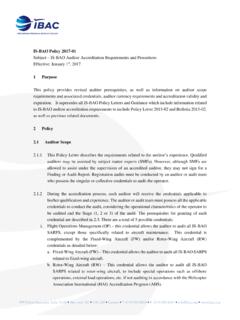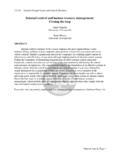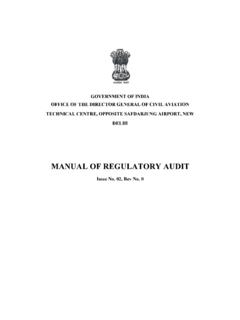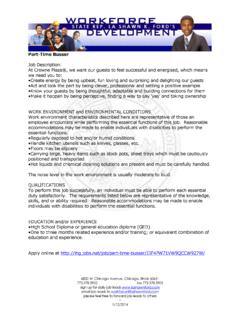Transcription of SPECIAL ISSUE: Focus on Leadership FORUM The …
1 Leadership vision and strategic DirectionBy Don BreckenFORUMFORUMA Peer-Reviewed Publication of the Quality Management Division of the American Society for QualityWinter 2004 Volume 30, Number 1 The Quality ManagementArticles published in The Quality Management Forummay not be reproduced without consent of the author(s).Creating a compelling vision and developinga strategy to achieve it, is one of Leadership sprimary functions. Historically, only top leadersunderstood the vision well enough to organizehuman and material resources to achieve it. Today,however, leaders at every level of the organizationmust understand the article provides an overview of theleader s role in creating the organization sfuture.
2 It examines Leadership vision , theunderlying themes common to effective vision ,and how vision works on many levels. It willalso examine how leaders formulate vision andstrategy. Finally, this article will discuss theleader s contribution to achieving the LeadershipExcellence in organizational performance doesnot come about by accident. It is a consciouschoice made by organizational leaders. Top leadersknow their organization s environment, have afive- or ten-year vision for the organization, andset believable plans to achieve their vision . However,in this complex and ever-changing world, anticipat-ingthe future can be very difficult. The authorsof Leaders: The Strategies for Taking Charge, Warren Bennis and Burt Nanus, agree and addthat the.
3 Problems of organizations are increas-inglycomplex. There are too many ironies,polarities, dichotomies, dualities, ambivalence,paradoxes, confusions, contradictions, contraries,and messes for any organization to understandand deal with. 1 This complexity explains whymany leaders are more comfortable focusing onclear, short-term goals than on uncertain, long-term visions. But what will the future hold for those whofail to consider it? Failing to anticipate yourcustomer s future needs, for instance, could putyou at risk of losing business to competitors whodo anticipate these needs and are able to fulfillthem. This means leaders must anticipate theirfuture needs and position their organizationproperly to fulfill those needs.
4 It is the respon-sibility of organizational strategic Leadership toconsider the external and internal business environ-ment and make sense of complexity when creatingthe organization s vision , mission and strategies,and planning their VisionOrganizational leaders must create a com-pelling vision that will inspire and motivatetheir employees. A vision is more than just adream. It is an ambitious view of the futurethat everyone in the organization can believein, one that can realistically be achieved, yetoffers a future that is better in important waysthan what now exists. 2 vision is what guidesINSIDE THIS ISSUEFrom the Chairman .. 2 Leadership Characteristics for Quality Performance.
5 3 Why certify? .. 5 Quality Leadership , Situational Style .. 8 The Physics of Change Leadership .. 12 The Whole Leader: TwoApproaches to Integrity .. password for the members only section on the ASQ-QMD Web site is:w04frm(LEADERSHIPVISION, continued on page 6) SPECIAL ISSUE: Focus on Leadership THE QUALITY MANAGEMENT FORUM6everyone in an organization down the samepath and at the same pace. When a vision isclearly articulated and followed .. everydaydecisions and actions throughout theorganization respond to current problemsand challenges in ways that move theorganization toward the future rather thanmaintain the status quo. 2An organization svision must link the present to the future,energize people and garner commitment,give meaning to work and establish a stan-dard of excellence.
6 vision links the present to the future .. vision is about getting from here to there;from what s going on today to what musthappen tomorrow. The trouble with today sorganizations is that managers spend mostof their time dealing with current problemsand relatively little time contemplating,visualizing and preparing for the leaders are those who handle thedaily challenge of obtaining short-termgoals and Focus on the future as well. vision energizes people and garnerscommitment ..A powerful vision willchallenge people to give their best effort. vision needs to transcend the bottom linebecause people are willing, and even eager,to commit to something truly worthwhile,something that makes life better for othersor improves their communities.
7 2 vision gives meaning to work ..Employees need to know their work hasmeaning. Work is more than just a pay-check for many. People love having a largerpurpose for what they do and they want tofeel pride in their work. A good vision cangive larger meaning to work by clarifyingits purpose, its interrelationship with otherwork and its impact on the organization asa establishes a standard of excellence .. vision provides measures bywhich contributions to the organization aregauged. A good vision brings out the bestby speaking to the hearts of employees, lettingthem be a part of something bigger thanthemselves. 2A good vision clarifies an imageof an organization s future, lets employeessee how they can contribute, and enablesemployees to reach higher-levels of excellence.
8 Is there a standard how to book forcreating Leadership vision ? Not according toMax DePree, author and chairman and CEOof Herman Miller, Inc., who writes, Leadershipis an art, something to be learned over time,not simply by reading books. Leadership ismore tribal than scientific, more a weavingof relationships than an amassing of infor-mation, 3 Powerful and effective visions,however, have five common themes: theyhave broad, widely shared appeal; they helporganizations deal with change; they encouragefaith and hope for the future; they reflect highideals; and they define both the organization sdestination and the basic rules to get there. 2 Mission StatementsOrganizations with powerful and effectivevisions will likely have a mission statement.
9 The mission is the organization s core broadpurpose and reason for existence. It definesthe company s core values and reason forbeing, and it provides a basis for creatingthe vision . 2An organization s mission shouldcommunicate what the company is such, it should be persistent and not changetoo often. Typically, a mission has two parts:the core valuesand core purpose. The core valuesare what guide the organization. The purpose ..captures people s idealistic motivationsfor why the organization exists. 2 Some companies choose to combinetheir vision and mission statements. Whatis important to remember about the two isthat the vision continually evolves, whilethe mission remains relatively constant.
10 Themission should endure to lend stability to theorganization in times of change and guidestrategic choice and decisions about the future. Strategy FormulationStrong, powerful organizations requiremore than just vision and mission statementsto be effective. They need to formulate strate-gies to translate vision , values and purposeinto action. This is called strategic manage-ment. strategic management is the set ofdecisions and actions used to formulate andimplement specific strategies that will achievecompetitively superior fit between the organi-zationand its environment so as to achieveorganizational goals. 2 The strategic leadermust find this fit and translate it into leader must develop strategies.








